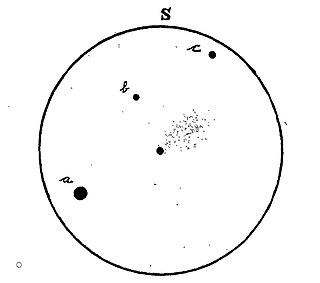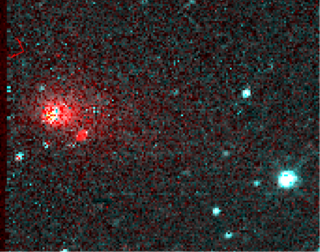Related Research Articles
Comet 87P/Bus is a periodic comet with an orbital period of 6.5 years. It fits the definition of an Encke-type comet with. It was discovered by Schelte J. Bus in 1981 on a plate taken with the 1.2m UK Schmidt telescope at Siding Spring, Australia. The discovery was announced in IAU Circular 3578 on March 4, 1981.

10P/Tempel, also known as Tempel 2, is a periodic Jupiter-family comet with a 5 year orbital period. It was discovered on July 4, 1873 by Wilhelm Tempel. The next perihelion passage is 2 August 2026 when the comet will have a solar elongation of 164 degrees at approximately apparent magnitude 8. Closest approach to Earth will be one day later on 3 August 2026 at a distance of 0.414 AU (61.9 million km).

28P/Neujmin, also known as Neujmin 1, is a large periodic comet in the Solar System. With a perihelion distance of 1.5AU, this comet does not make close approaches to the Earth.

49P/Arend–Rigaux is a periodic comet in the Solar System.

52P/Harrington–Abell is a periodic comet in the Solar System.

60P/Tsuchinshan, also known as Tsuchinshan 2, is a periodic comet in the Solar System with an orbital period of 6.79 years. Tsuchinshan is the Wade-Giles transliteration corresponding to the pinyin Zĭjīn Shān, which is Mandarin Chinese for "Purple Mountain".

77P/Longmore is a periodic comet in the Solar System, with a period of 6.8 years.
91P/Russell, also known as Russell 3, is a periodic comet in the Solar System. It was discovered by Kenneth S. Russell in 1983.
152P/Helin–Lawrence is a periodic comet in the Solar System.
158P/Kowal–LINEAR is a periodic comet in the Solar System that has an orbit out by Jupiter.
165P/LINEAR is a periodic comet in the Solar System. 165P/LINEAR has a perihelion distance of 6.8 AU, and is a Chiron-type comet with.

Comet Finlay is a periodic comet with an orbital period of 6 years discovered by William Henry Finlay on September 26, 1886. The next perihelion passage is July 13, 2021 when the comet will have a solar elongation of 54 degrees at approximately apparent magnitude 10. It last came to perihelion on December 27, 2014, at around magnitude 10. Of the numbered periodic comets, the orbit of 15P/Finlay has one of the smallest minimum orbit intersection distances with the orbit of Earth (E-MOID). In October 2060 the comet will pass about 5 million km from Earth.
178P/Hug–Bell is a periodic comet in the Solar System. It was discovered by Northeast Kansas Amateur Astronomers' League members Gary Hug and Graham Bell and is thought to be the first periodic comet to be discovered by amateurs. It was declared a comet less than two days after its initial discovery, after having its course confirmed on previous images.

Comet Kopff or 22P/Kopff is a periodic comet in the Solar System. Discovered on August 23, 1906, it was named after August Kopff who discovered the comet. The comet was missed on its November 1912 return, but was recovered on its June 1919 return and has been seen at every apparition since. Close approaches to Jupiter in 1938 and 1943 decreased the perihelion distance and orbital period. 22P/Kopff’s last perihelion passage was 18 March 2022. On 13 July 2028 it will pass 0.353 AU (52.8 million km) from Earth.

68P/Klemola or Klemola's Comet is a periodic comet, which belongs to Jupiter's comet family, that was discovered in 1965 by American astronomer Arnold Richard Klemola in Argentinian Yale-Columbia Southern Station. Its orbital period is 10.82 years.
255P/Levy, formerly P/2006 T1 and P/2011 Y1, is a periodic comet with an orbital period of 5.25 years. It last came to perihelion on 14 January 2012. During the 2006 passage the comet achieved an apparent magnitude of ~9.5. Levy (PK06T010) was believed to have been recovered on 3 June 2011 at magnitude 19.8, but other observatories were unable to confirm a recovery. It was most likely a false positive because of large residuals. Levy was recovered on 17 December 2011 at magnitude 19.8, and given the second designation 2011 Y1. It was then numbered.

62P/Tsuchinshan, also known as Tsuchinshan 1, is a periodic comet discovered on 1965 January 1 at Purple Mountain Observatory, Nanking. It will next come to perihelion on 25 December 2023 at around apparent magnitude 8, and will be 0.53 AU (79 million km) from Earth and 110 degrees from the Sun.

246P/NEAT is a periodic comet discovered on 2004 March 28 by Near-Earth Asteroid Tracking (NEAT) using the 1.2-metre (47 in) reflector at Haleakala. It was given the permanent number 246P on 2011 January 14.

66P/du Toit is a periodic comet in the Solar System with a current orbital period of 14.78 years. It came to perihelion on 2018 May 19 at roughly apparent magnitude 12.
79P/du Toit–Hartley or du Toit 2 is a periodic comet, now divided into two parts, in the Solar System with an orbital period of 5.06 years. It next comes to perihelion in September 2023 but is only expected to reach about apparent magnitude 18. It will be less than 90 degrees from the Sun from February 2023 until June 2024. On 26 May 2024 it will be 2.7 AU from the Sun and Earth.
References
- 1 2 3 "51P/Harrington Orbit". Minor Planet Center. Archived from the original on 2022-06-20.
- ↑ "Horizons Batch for 51P-D (90000595) on 2022-Oct-01" (Perihelion occurs when rdot flips from negative to positive). JPL Horizons. Archived from the original on 2022-06-20. Retrieved 2022-07-06. (JPL#K222/5 Soln.date: 2023-May-04)
- ↑ Seiichi Yoshida (2016-05-14). "51P/Harrington". Seiichi Yoshida's Comet Catalog. Retrieved 2017-02-26.
- ↑ "Horizons Batch for 51P-A/Harrington (90000593) for Aug-Oct 2022". JPL Horizons. Archived from the original on 2022-06-21. Retrieved 2022-06-21. (JPL#K153/2, Soln.date: 2015-Oct-07)
- ↑ "Horizons Batch for 51P-A/Harrington (90000593) on 2022-Oct-03" (Perihelion occurs when rdot flips from negative to positive). JPL Horizons. Archived from the original on 2022-06-20. Retrieved 2022-06-20. (JPL#K153/2, Soln.date: 2015-Oct-07)
- ↑ "Horizons Batch for 51P-D (90000595) for Aug-Oct 2022". JPL Horizons. Archived from the original on 2022-06-21. Retrieved 2022-07-06. (JPL#K222/5 Soln.date: 2023-May-04
- Mobberley, Martin. Hunting and Imaging Comets. Google Books

